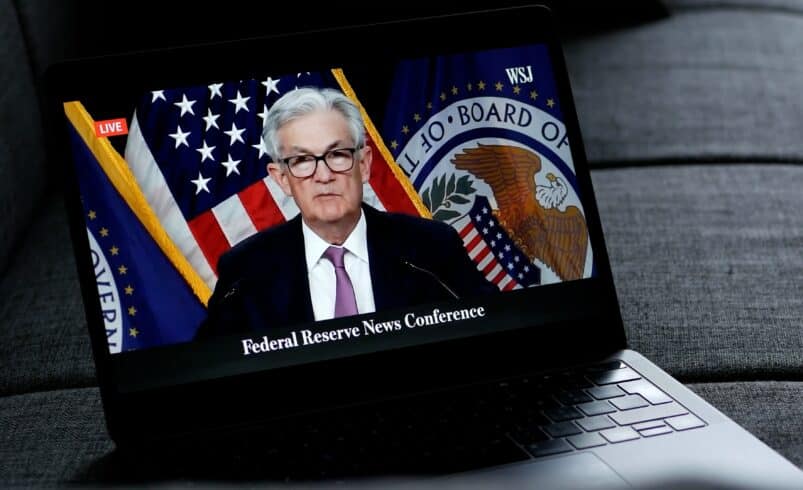Fed Chair Powell Expresses Cautious Optimism Amid Inflation Challenges

Key Insights:
- Despite aggressive rate hikes signaling ongoing economic challenges and the Fed’s vigilant approach, Powell is optimistic about inflation control.
- Market volatility follows Powell’s IMF speech, reflecting investor concerns over the uncertain economic future and the Fed’s balancing act between growth and inflation.
- Fed’s Powell acknowledges the need for potential further policy tightening, balancing risks and economic data in the fight against inflation.
Inflation Slows, but Uncertainty Remains
In his latest address at the International Monetary Fund in Washington, D.C., Jerome Powell, the Federal Reserve Chairman, underscored the central bank’s ongoing efforts to control inflation amidst the uncertain economic terrain. His comments mirrored a careful equilibrium between hopefulness and cautious watchfulness as the Federal Reserve evaluates its forthcoming actions in monetary policy.
Encouraging Signs Tempered by Caution
Powell acknowledged the recent slowdown in inflation as a positive development but stopped short of declaring victory. Despite the encouraging trend, he emphasized the Federal Reserve’s need for more confidence in achieving a sufficiently restrictive monetary policy stance to bring inflation down to its 2% target. This cautious tone underscores the complexity of the current economic scenario, where definitive conclusions remain elusive.
Since early 2022, the Federal Reserve has undertaken a historic series of 11 rate hikes, propelling the benchmark rate from near zero to a range of 5.25%-5.5%. This marks the most aggressive policy tightening since the 1980s, an apparent response to the inflation surge. These efforts have coincided with a reduction in the core personal consumption expenditures price index, the Fed’s preferred inflation measure, from 5.3% in February 2022 to an annual rate of 3.7%. Additionally, the widely tracked consumer price index has receded from its peak above 9% in June of the previous year.
Balancing Risks in Monetary Policy
In his speech, Powell highlighted the balance the Fed seeks to maintain between the risks of overtightening and being misled by short-term data improvements. The central bank remains prepared to tighten policy further if necessary, demonstrating its commitment to its inflation target. However, Powell also indicated the Fed’s readiness to move carefully, considering the potential impacts of its decisions on the broader economy.
This nuanced approach is evident in the market’s reaction to Powell’s speech. The Dow Jones Industrial Average saw a decline of nearly 200 points, while Treasury yields, which had been decreasing for most of the previous three weeks, experienced a rise. This response partly stemmed from a lackluster reception to a recent 30-year bond auction, highlighting the sensitivity of financial markets to the Fed’s policy signals.
Economic Resilience and Future Outlook
Looking forward, Chairman Powell characterized the U.S. economy’s performance in 2023 as notably strong, particularly in light of the widespread expectations of a recession. The economy demonstrated a significant 4.9% growth rate on an annualized basis during the third quarter, although Powell expects a more modest growth rate in the upcoming periods. Additionally, while remaining relatively low, the unemployment rate has slightly increased this year, a trend often associated with recessions.
The Federal Reserve is keenly aware that economic growth might exceed forecasts, which could challenge its efforts to manage inflation. Powell acknowledged that while improvements in supply chains have helped reduce inflationary pressures, the extent of further benefits from such changes remains uncertain. He suggested that a more significant portion of the effort to bring down inflation might come from maintaining a strict monetary policy to control overall demand growth.
Powell’s speech at the IMF underscores a Federal Reserve encouraged by recent progress but remains cautious and ready to act against inflation. This balanced approach reflects an awareness of the intricate interplay between aggressive policy measures, economic growth, and market stability.
Editorial credit: Domenico Fornas / Shutterstock.com
DISCLAIMER: It's essential to understand that the articles on this site are not meant to serve as, nor should it be construed as, advice in legal, tax, investment, financial, or any other professional context. You should only invest an amount that you are prepared to lose, and it's advisable to consult with an independent financial expert if you're uncertain. To obtain more information, kindly examine the terms of service and the assistance and support resources made available by the issuing or advertising entity. Our website is committed to delivering accurate and unbiased news, yet it's important to note that market conditions may change rapidly. Also, be aware that some (but not all) articles on our site are compensated or sponsored.








